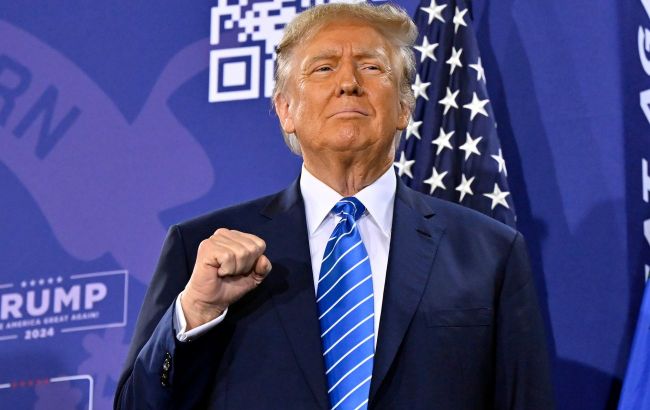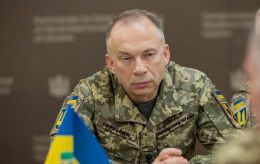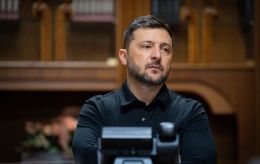From Congo to Ukraine. How Trump 'ends global conflicts' - is the Nobel Peace Prize next?
 Photo: US President Donald Trump (Getty Images)
Photo: US President Donald Trump (Getty Images)
President of the USA Donald Trump is attempting to end not only the Russia‑Ukraine war, but also other conflicts around the world.
RBC‑Ukraine reports on how successful he has been and whether Trump’s declarations about the "end of war" always correspond to reality.
Key questions:
- What did Trump promise Thailand and Cambodia in exchange for peace?
-
How did the USA help India and Pakistan, and did they heed Washington?
-
What was the outcome of the US mediation between Rwanda and the DRC?
White House spokeswoman Caroline Levitt stated that it is high time to award President Donald Trump a Nobel Peace Prize. She cited his active peacemaking efforts.
"This means that President Trump has brokered on average one peace deal or ceasefire per month during his six months in office," Levitt said.
Trump himself does not hide his desire for the Nobel Peace Prize, as it was awarded to his predecessor, Barack Obama. Moreover, Trump has already been nominated for the award by Israel, Pakistan, and Cambodia.
However, in practice, the role of the US president has not always been decisive in conflict resolution, and the conflicts themselves do not always conclude following his declarations of peace.
Thailand and Cambodia
The conflict between Thailand and Cambodia unexpectedly flared at the end of July after a shooting on the border. The militaries of both countries accused each other of provocation. At least 36 people were killed. The clashes did not last long. On July 28, Trump declared the war over.
"I am pleased to announce that, after the involvement of President Donald J. Trump, both Countries have reached a ceasefire and peace," he wrote on Truth Social.
According to US media, Trump threatened to suspend trade agreements with both countries if hostilities did not cease. Ultimately, leaders of Thailand and Cambodia met in Malaysia to reach an agreement. Southeast Asian media emphasizes that mediation by Malaysia and China, significant equipment losses, and public dissatisfaction in both countries played a decisive role.
For example, Thai PBS reported that public discontent grew after canceling celebrations for King Maha Vajiralongkorn’s birthday. Meanwhile, tensions at the border remain high and could escalate again.
India and Pakistan
At the end of April, another conflict between India and Pakistan erupted after a terrorist attack in disputed Kashmir that killed 26 civilians. India accused Pakistan of supporting militants and launched missile strikes on potential camps in Pakistan. Pakistan retaliated, and cross-border skirmishes occurred. The conflict subsided within three days.
The US maintained contact with both countries through Secretary of State Marco Rubio and Vice President J.D. Vance. According to sources cited by The New York Times, Vance urged Prime Minister Modi to consider alternatives to further strikes and offered possible "off-ramps" for Pakistan—though Modi made no specific commitments. Rubio conversed with Pakistani General Asim Munir.
The US role remains contested: Pakistan claims Washington’s input was significant, while India insists the conflict was resolved directly without intermediaries.
Trump later claimed his threats to suspend trade talks and offer expanded commerce in return for de-escalation influenced the ceasefire.
Neither country sought a prolonged conflict—making Washington’s diplomatic efforts easier. CNN noted that the US “pressed on open doors,” facilitating a quick outcome.
Rwanda and DR Congo (DRC)
The conflict between the DRC and Rwanda has persisted since the 1990s but escalated earlier this year due to the M23 rebel group, backed by Rwanda, advancing into Congo.
On June 27, 2025, foreign ministers from the DRC and Rwanda signed a peace agreement in Washington under US and Qatari mediation. Trump hailed it as a "magnificent triumph," saying his administration played a key role through talks and meetings.
According to The Washington Post, the deployment was led by Vice President Vance and Secretary of State Rubio. Nigerian billionaire and adviser to Trump’s daughter Tiffany’s husband, Masad Boulos, helped merge separate peace proposals into one document. The New York Times reports Boulos instrumental in unifying the agreements.
Washington tied its support to Congo’s access to its mineral wealth—tantalum, cobalt, copper, and lithium—essential for tech development and competition with China.
Although Trump called the deal pivotal, the M23 did not participate in negotiations nor agree to disarm. A spokesperson confirmed M23’s commitment to concurrent talks in Qatar, not Washington. Violations began soon after signing, and low-intensity clashes have continued.
Israel and Iran, but not Hamas
The conflict between Israel and Iran has been ongoing for several decades. After the Islamic Revolution of 1979, Iran declared its goal — to destroy Israel. Since then, it has created a network of groups throughout the Middle East that promote its interests and, from time to time, attack Israel. In addition, Iran has worked on creating nuclear weapons, which in Israel were viewed as an existential threat.
On June 12, Israel carried out a preemptive massive strike on nuclear facilities, air defense, and military command of Iran. The reason for the strikes was Israeli intelligence data, which showed that Tehran was very close to creating nuclear weapons. Accordingly, the "point of no return" could soon come, after which the nuclear program could no longer be stopped. In response, Iran launched drone and missile strikes on Israel.
The United States, both earlier and during the 12-day war, maintained contact with both sides, and by its end joined the attacks on Iran. Part of Iran’s nuclear facilities are located deep underground, and thus are invulnerable to Israeli attacks. The only means capable of destroying them — GBU-57 bunker-busting bombs — are only in service with the USA. Eventually, American B-2 bombers used them, after which Trump announced that the nuclear program had been destroyed and the war was over.
As several independent sources later confirmed, this is not entirely accurate. American bombs only partially damaged underground facilities. In addition, Iran could have removed part of the already enriched uranium for nuclear warheads. But considering the overall serious losses in the conflict, the Iranian leadership entered into dialogue. Currently, negotiations are underway between the US and Iran on the future of the nuclear program. They are being supervised by US Special Representative for the Middle East Stephen Witkoff, who is also responsible for dialogue with Russia.
By intervening in this conflict, Trump is solving a problem that he created during his first presidential term. In 2015, an agreement was concluded between Iran and six Western countries, which provided for control over the nuclear program in exchange for lifting part of the sanctions on Iran. However, in 2017, Trump unilaterally withdrew the US from the agreement and reinstated sanctions. Iran, in turn, began working more actively on nuclear weapons. During the current negotiations, a partial return to the 2015 situation has occurred.
Lessons for Ukraine
During negotiations to end the Russian-Ukrainian war, Trump is employing the same tools and behavioral models as in other cases: shuttle diplomacy, threats of sanctions, and trade tariffs. The US also does not forget about its own economic interests and access to critically important resources.
However, in most other cases where Trump succeeded in "ending wars," the parties to the conflict themselves were also interested in this. However, in the Russian-Ukrainian war, Moscow has so far shown no desire to pursue peace, and this is one of the most difficult scenarios for Trump.
Suppose the US president nevertheless decides to put pressure on Russia and forces it to make peace. In that case, his chances of receiving the Nobel Peace Prize really rise sharply, because the Russian-Ukrainian war is the largest armed confrontation in Europe in the past 80 years.
Sources: materials from Thai PBS, CNN, The New York Times, Washington Post, and Politico.

